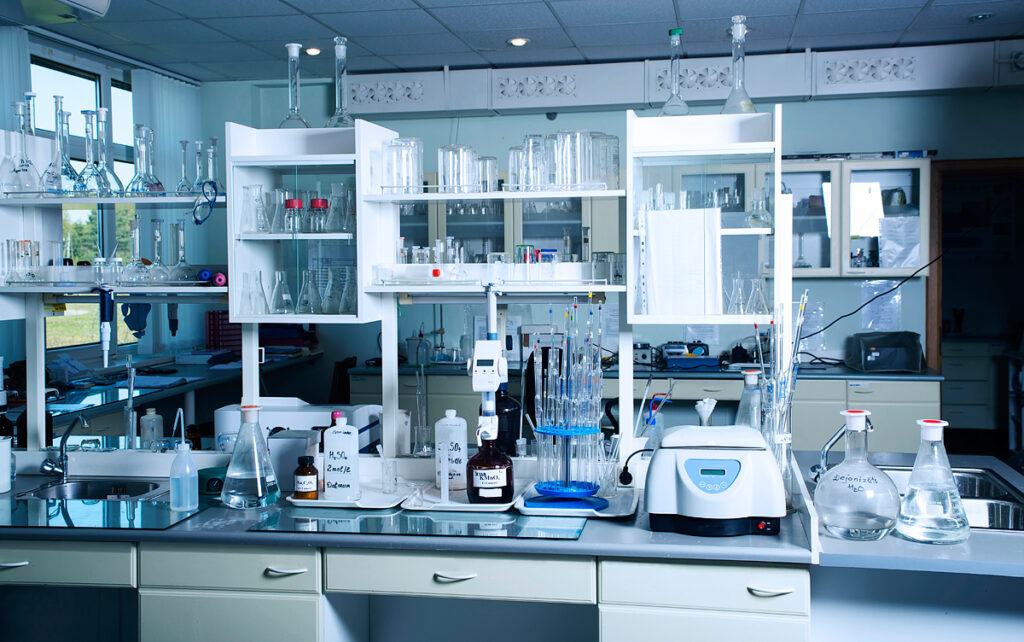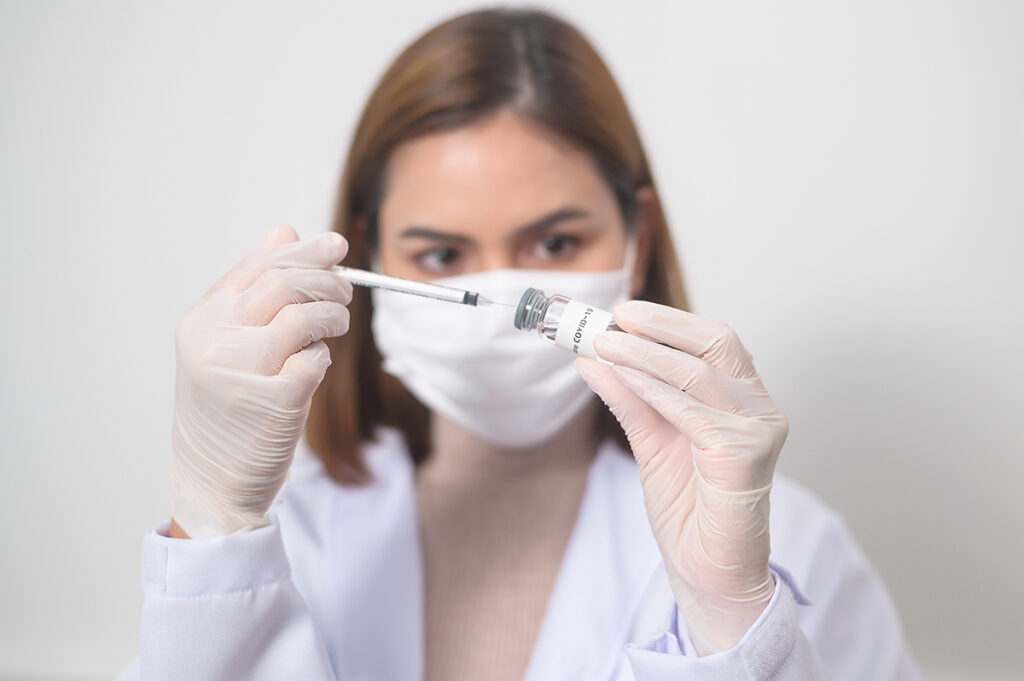Pathophysiology of the SARS-CoV-2 coronavirus
The most common symptoms of coronavirus are fever, myalgia, dry cough, loss of smell and taste, fatigue, and diarrhea. They can last about a week. If the immune system cannot stop the virus, it will continue to attack the body, and the patient will develop shortness of breath and a decrease in the number of vital cells of the immune system – lymphocytes. Furthermore, the immune system’s response to infection will be ineffective.
The outcome of COVID-19 determines the innate immune response. The antiviral response of the immune system is regulated by signaling molecules-type I interferons (IFN, IFN). They stimulate the cells of the immune system that destroy pathogens: macrophages and natural killer cells (NK). In viral pathogens, interferons are secreted by infected cells, preparing the body for a possible viral infection.
Interferon is involved in the occurrence of fever. Previous studies have shown that the SARS-CoV-2 coronavirus suppresses or delays IFN-I, especially at the onset of infection. It may explain why some people have no symptoms at an early stage of the disease.
The coronavirus suppresses the immune system. A study analyzing the development of a mild case of SARS-CoV-2 showed a sharp decrease in NK cells and monocytes, which appear to be a target for the coronavirus. Patients with a lower IFN response tend to have a worse prognosis and a higher risk of death from coronavirus infections. People with chronic diseases (cardiovascular diseases, hypertension, obesity, diabetes) are more susceptible to SARS-CoV-2 infection, possibly because SARS-CoV-2 affects the walls of blood vessels and causes inflammation. Conversely, children have a solid immune response against viral infections. That explains why less than 2% of all confirmed COVID-19 cases in the U.S. are children, even though they make up 22% of the entire U.S. population.
Fever and hydrothermotherapy against viruses
Coronaviruses do not tolerate heat, alkaline, and acidic pH. The virus likes low temperatures: it is more stable at 4°C. For the prevention and treatment of mild coronavirus SARS-CoV-2, scientists recommend hydrothermotherapy.
Hydrothermotherapy is therapeutic heating using water. These are hot compresses and baths, as well as a bath and sauna. Hydrothermotherapy creates an artificial fever in the body which provides better survival and shorter disease duration.
Heat has an antiviral effect. When scientists submerged a container of human cells and rhinovirus in a bath of hot water at 45 °C, the heat suppressed the virus by 90% but did not kill the human cells.
Infectious agents can cause fever, which is a defense mechanism. Fever is triggered when monocytes encounter pathogens. That leads to an increase in the inflammatory and immune mediator IL-1 (interleukin 1), which causes fever since IL-1 increases body temperature. IL-1 is also involved in the activation of the cellular and humoral immune response against the pathogen. Fever promotes the migration of white blood cells and neutrophils to the area where the pathogen is located and activates T cells.
Sauna stimulates the immune system and increases the level of interferon
For thousands of years, people have used heat treatment: Finnish sauna, Russian bath, Turkish hammam. There are references in 3000 BC to Indian steam baths.
Sauna is the most studied method of hydrothermotherapy. The temperature in the sauna is from 80 to 100 °C, and the relative humidity is from 10 to 20%, increasing when hot stones are watered with water. The usual length of stay in the sauna for adults is from 5 to 20 minutes and 5 to 10 minutes for children. A quick cooling follows the sauna to stop sweating. Studies show that the cooling stage increases the number of white blood cells.
Cooling is carried out at room temperature or with the help of snow or ice water. Rapid cooling has a positive effect on the heart and vascular function. However, patients with cardiovascular diseases should not be cooled by immersion in cold water. For them, it will be safer to cool down, for example, a shower gradually.
During the sauna, the body temperature rises to 39 °C for 15-20 minutes. That causes dilation of the skin’s blood vessels, leads to a loss of about 500 g of weight due to sweating, causes an increased pulse rate, and reduces peripheral vascular resistance. The hematological effects of the sauna are an increase in hemoglobin, the number of white blood cells and platelets within the normal range. The sauna also reduces the level of serum C-reactive protein (CRP), a marker of systemic inflammation. High levels of CRP, i.e., high levels of inflammation, can negatively affect immunity. In comparison, lower levels of CRP are associated with less systemic inflammation.
The sauna reduces the frequency of colds. In a small study (9 athletes and 9 non-athletes), after one session of the Finnish sauna, the number of white blood cells increased, and the response was higher in athletes and included an increase in neutrophils and monocytes. A cohort study of Finnish sauna users demonstrated a reduction in systemic inflammation and oxidative stress.
Heat treatments can prevent a cytokine storm. Treatment with hyperthermia results in high levels of IL-6 without the activation of IL-1-beta and tumor necrosis factor (TNF). That potentially precludes the immune response regulation from being disrupted, as an increase in one IL-6 reduces inflammation. It is confirmed by a study in mice, which showed that endogenous IL-6 plays a crucial anti-inflammatory role in both local and systemic acute inflammatory reactions, controlling the level of pro-inflammatory, but not anti-inflammatory cytokines, and these anti-inflammatory actions of IL-6 cannot be compensated by IL-10 or other members of the IL-6 family. Isolated increases in IL-6 levels are a way to reduce inflammation during exercise, fasting, and plant-rich diets.
Hyperthermia increases the level of interferon. The optimal effect on coronavirus infection with interferon is possible at temperatures from 39.5 to 40.5 °C. In cell cultures, hyperthermia causes the synthesis of interferon-gamma. In rhesus macaques, hyperthermia increases the level of interferon-alpha and the level of non-interferon antiviral factors. All this counteracts the virus since interferon can slow or stop viral infections.
Another possible mechanism for how hyperthermia may work against viruses is increased membrane fluidity in both the virus and the target cells. This affects the specific viral pathogenesis associated with the release, assembly, penetration, and attachment of the virus to the cell it is trying to attack.
Studies confirm the benefits of sauna not only for the immune system but also for the cardiovascular, respiratory, and integumentary systems:
- Regular sauna use is associated with a reduced risk of hypertension.
- Bathing in the sauna reduces the risk of respiratory diseases.
- Bathing in the sauna helps to remove hyperkeratotic scales in psoriasis. Dermatophytes and other infectious microorganisms die in the heat of the sauna.
Risks and benefits
Sauna and alcohol are incompatible. A survey of deaths of people using saunas in Finland from 1990 to 2002 shows less than 2 cases per 100,000 inhabitants, with alcohol consumption being the most common cause of death in saunas.
A study of the risks of visiting a sauna showed:
- the sauna is well tolerated and does not pose a danger to healthy people of any age;
- the sauna does not pose a particular risk for patients with hypertension, coronary heart disease, and heart failure if these patients are taking medication and are stable.
Electron microscopy of the lungs after the sauna showed no damage to the epithelium of the respiratory tract. However, you should avoid going to the sauna during acute respiratory infections. Sympathomimetic drugs can cause tachycardia and arrhythmia in the sauna. One of the absolute contraindications for visiting a sauna is a high temperature.
Hot baths improve immunological parameters
Hot baths are another means of warming the body and improving immune markers. In a study of 12 healthy men and women, participants were immersed in a hot bath at 39.5 °C for 2 hours to simulate an artificial fever and test its effect on monocytes and TNF-alpha. The laboratory part of the study showed that after a hot bath, the level of CD14 and CD11b receptors, which are helpful for infections, increased. When part of the in vivo study was conducted 3 hours after hyperthermia, the monocyte response to endotoxins improved, as evidenced by greater TNF-alpha release. This study concluded that hydrothermotherapy activates monocytes and prepares them to respond to infections.
Another study on 7 healthy men demonstrated the effect of hydrothermotherapy followed by cold treatment on the immune system. Heat followed by cold therapy significantly increased the number of white blood cells, granulocytes, lymphocytes, and monocytes. The researchers concluded that short-term cooling after heat treatment effectively increased white blood cell count, NK cell activity, and IL-6 levels. Preliminary physical exercises enhanced the effect.
Experience in using hydrothermotherapy
During the Spanish flu pandemic of 1918, which claimed the lives of 50 to 100 million people, hydrothermotherapy was used in sanatoriums as a means of helping the body fight various diseases. Hydrothermotherapy included hot water baths, poultices, steam baths, and wet sheets. The death rate from the pandemic in hospitals that did not use hydrothermotherapy was 6.7%. A report at the time showed that of the 1,123 documented cases of Spanish flu in the sanatorium, 446 were treated inpatient (received hydrothermotherapy), and 677 were treated outpatient (also received hydrothermotherapy). Only 1.3% of patients with Spanish flu died in the sanatorium hospital, and 3.8% died on an outpatient basis. Although many uncontrolled factors need to be considered, these data show that hydrothermotherapy is an essential factor associated with survival after the Spanish flu.
Conclusions. How to warm your body against COVID-19
All the above data can be summarized in two main findings:
- An increase in body temperature weakens the virulence of the virus and/or increases the body’s immunity.
- The use of thermal treatments, such as steam baths, saunas, or hot baths with water from 33.5 to 40 °C, is associated with a lower incidence of viral infections and lower mortality from viral diseases, including COVID-19, when applied for 5-20 minutes, followed by cooling to stimulate the immune response.
The use of hydrothermotherapy does not necessarily require expensive equipment. The reality is that any way to warm the body to inactivate the coronavirus is better than none. Hydrothermotherapy can be used at home. The easiest way is a hot shower followed by a cold shower.
Regular use of heat followed by cold is a practical approach to preventing and treating mild to moderate infections caused by the SARS-CoV-2 coronavirus. If many people follow this approach, the impact of the coronavirus on the world population will decrease.
Useful article, necessary information? Share it!
Someone will also find it useful and necessary:
Source
Hydrothermotherapy in prevention and treatment of mild to moderate cases of COVID-19



